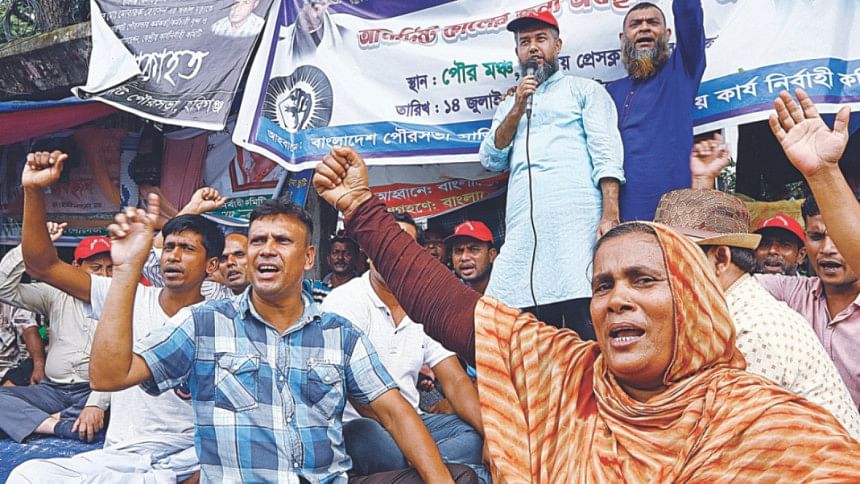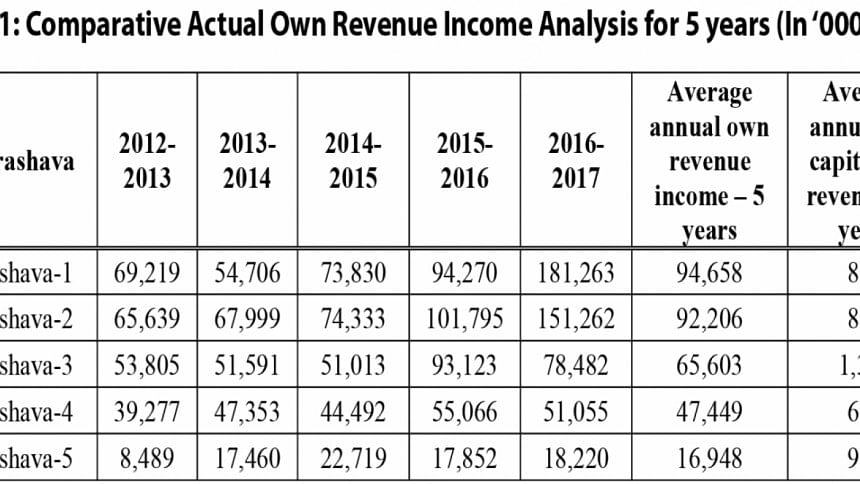Revenue base has to be improved to overcome emerging issues

City corpora-tions and Paurashavas constitute the municipalities in Bangladesh. There are 331 municipalities comprising of 11 city corporations and 320 Paurashavas in the country. The recent demand by municipal employees for payment of their arrear salaries and benefits laid bare the inherent weaknesses of the urban local bodies. As reported by The Daily Star quoting government sources, a total amount of Tk 692 crore has piled up as arrear salaries of the municipal employees. Over 35,000 employees of 260 municipalities did not receive their salaries for up to seven years. Of them, 6,000 staff did not receive salaries for five years, about 12,000 for two years and around 5,000 for a year, as per the Bangladesh Association of Paurashava Services (BAPS).
Sound financial management of local government bodies is essential for the long-term health and sustainable development of urban areas in any country. Local governments around the world are playing an increasingly important role in the delivery of basic public services. But local authorities also face great challenges in funding infrastructure development and maintenance and ensuring a decent level of service delivery. Most urban local bodies in Bangladesh are increasingly facing complex financial challenges as a result of rapid urbanisation. It is widely believed that adequacy of its own revenues is key to a local government's improved ability to deliver public services, thereby leading to increased accountability of local officials to their constituents.
Local government strengthening should receive high priority in line with the government policies. The "Perspective Plan of Bangladesh 2010-2021" duly recognises the critical role of local government institutions (LGIs) for establishing good governance and promoting local development, and envisions devolution of power, functions, and fiscal authority to LGIs over the long term.
Bangladesh experienced sustained urbanisation for the last three decades fuelled by strong economic growth. The country has achieved respectable economic growth over the last two decades with a Gross Domestic Product (GDP) growth rate averaging 6-7 percent per annum that reached 8.1 percent in 2018-19. The country aims to reach "middle-income" status by 2021 from its current status as lower middle-income. Accordingly, its Sixth Five-Year Plan (2011-15) and Seventh Five-Year Plan (2016-2020) envisage: i) GDP growth of more than 8 percent per annum from fiscal year 2020 by mobilising higher domestic and foreign investment and harnessing the labour force by making the most of the demographic dividend. In addition, the plans strive to raise the productivity of capital and labour by adopting new technologies and stimulating the widespread application of digital technology to meet the objectives of the Perspective Plan (2010-2021) and Vision 2021; ii) accelerated growth of employment to absorb the new entrants to the labour force; and iii) moving people from low-productive agriculture to more productive manufacturing sector.

The economic growth has been accompanied by structural transformation. The contribution of agriculture to GDP reduced from 30 percent in 1990 to 16.11 percent in 2016, while the contribution of the urban sector to GDP increased from 37 percent to 66 percent over the same period. As a result, the percentage of people below the poverty line declined from 56.6 percent in 1992 to 22.7 percent in 2016.
Bangladesh is rapidly urbanising and great pressure is exerted on basic urban services, particularly in the Paurashavas. The percentage of population in urban areas rose from 15 percent in 1980 to 37.5 percent in 2016. The urban centres are characterised by poor infrastructure and low level of urban services. For example: i) road space is inadequate and not well maintained, and traffic congestion is severe; ii) drainage systems are not well planned, the drains are not cleaned regularly and do not function satisfactorily; iii) water supply is inadequate and unsafe; iv) solid waste management practices are weak; v) street lighting is unsatisfactory; and vi) pollution levels of water, air, soil, and noise have increased.
The municipalities lack adequate own-source revenues to finance new investments and operations and maintenance. The current sources of revenue for municipalities are: i) central government fiscal transfers from the GoB's Annual Development Programme (ADP); and ii) own-source revenues, e.g. holding tax and rates, fees and income from leasing and renting of Paurashava assets. Collection performance for the major source of revenue, the holding tax, ranges around 30 percent to 40 percent. The municipalities will continue to depend on the financial transfers from GoB to meet investment and recurrent expenditures for the foreseeable future. However, government resources and municipalities' own income are not adequate to finance necessary infrastructure and services such as roads, drains, water treatment plants, street lights, solid waste collection and disposal, and regular salaries of municipal staff.
The revenue base of the Paurashavas in general is weak and revenue potential has not been fully exploited. However, the revenue performance of the local bodies varies from one Paurashava to the other. Table 1 provides an idea about the actual annual own-source revenue collection of five Paurashavas but their names have intentionally not been mentioned here.
Inadequate infrastructure and services are a perennial issue for urban local governments. Without proper infrastructure facilities, the urban environment rapidly deteriorates, risking the health of the people. The municipalities depend heavily on intergovernmental fiscal transfers for preparing their revenue and development budgets. This situation is not desirable. For delivering improved services and infrastructure, own-source revenue generation should be given high priority by the local bodies.
Dr Nawshad Ahmed is an economist and urban planner. He has worked previously as a UN official in Bangladesh and abroad.

 For all latest news, follow The Daily Star's Google News channel.
For all latest news, follow The Daily Star's Google News channel. 



Comments